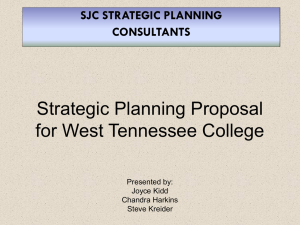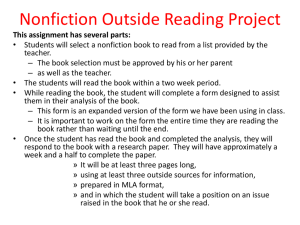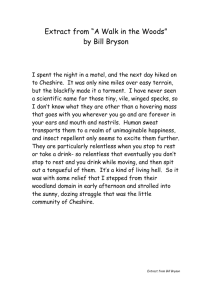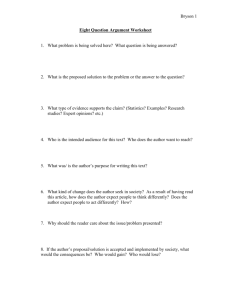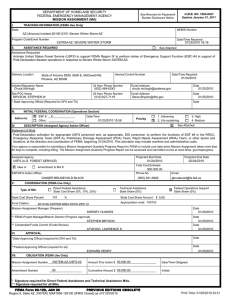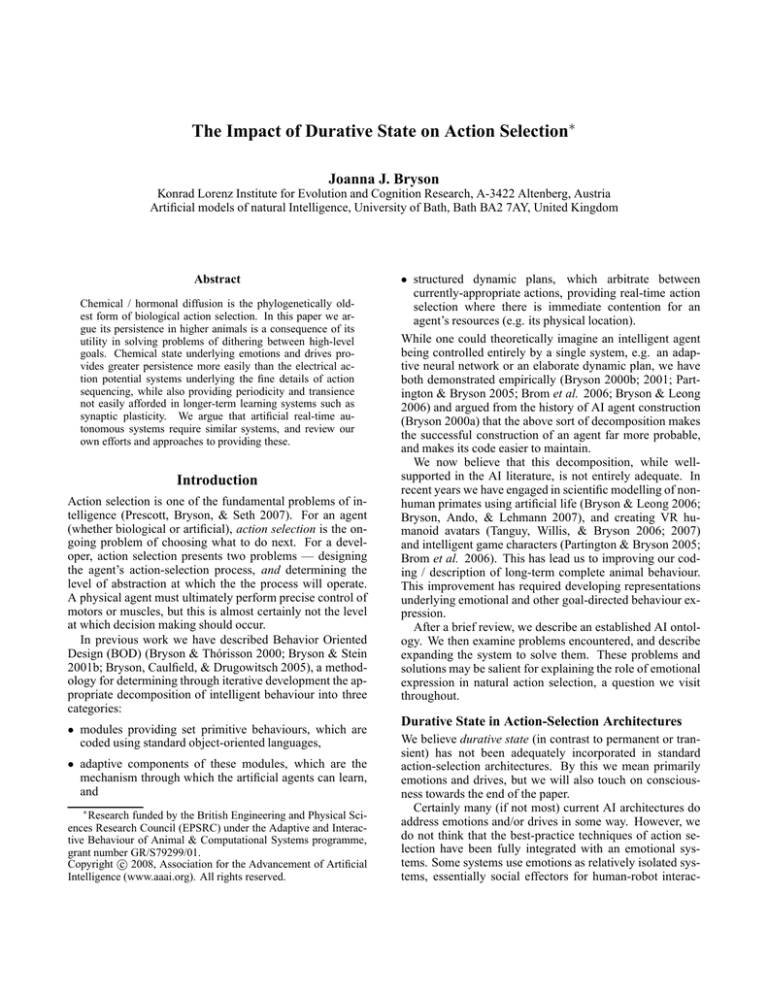
The Impact of Durative State on Action Selection∗
Joanna J. Bryson
Konrad Lorenz Institute for Evolution and Cognition Research, A-3422 Altenberg, Austria
Artificial models of natural Intelligence, University of Bath, Bath BA2 7AY, United Kingdom
Abstract
Chemical / hormonal diffusion is the phylogenetically oldest form of biological action selection. In this paper we argue its persistence in higher animals is a consequence of its
utility in solving problems of dithering between high-level
goals. Chemical state underlying emotions and drives provides greater persistence more easily than the electrical action potential systems underlying the fine details of action
sequencing, while also providing periodicity and transience
not easily afforded in longer-term learning systems such as
synaptic plasticity. We argue that artificial real-time autonomous systems require similar systems, and review our
own efforts and approaches to providing these.
Introduction
Action selection is one of the fundamental problems of intelligence (Prescott, Bryson, & Seth 2007). For an agent
(whether biological or artificial), action selection is the ongoing problem of choosing what to do next. For a developer, action selection presents two problems — designing
the agent’s action-selection process, and determining the
level of abstraction at which the the process will operate.
A physical agent must ultimately perform precise control of
motors or muscles, but this is almost certainly not the level
at which decision making should occur.
In previous work we have described Behavior Oriented
Design (BOD) (Bryson & Thórisson 2000; Bryson & Stein
2001b; Bryson, Caulfield, & Drugowitsch 2005), a methodology for determining through iterative development the appropriate decomposition of intelligent behaviour into three
categories:
• modules providing set primitive behaviours, which are
coded using standard object-oriented languages,
• adaptive components of these modules, which are the
mechanism through which the artificial agents can learn,
and
∗ Research funded by the British Engineering and Physical Sciences Research Council (EPSRC) under the Adaptive and Interactive Behaviour of Animal & Computational Systems programme,
grant number GR/S79299/01.
c 2008, Association for the Advancement of Artificial
Copyright Intelligence (www.aaai.org). All rights reserved.
• structured dynamic plans, which arbitrate between
currently-appropriate actions, providing real-time action
selection where there is immediate contention for an
agent’s resources (e.g. its physical location).
While one could theoretically imagine an intelligent agent
being controlled entirely by a single system, e.g. an adaptive neural network or an elaborate dynamic plan, we have
both demonstrated empirically (Bryson 2000b; 2001; Partington & Bryson 2005; Brom et al. 2006; Bryson & Leong
2006) and argued from the history of AI agent construction
(Bryson 2000a) that the above sort of decomposition makes
the successful construction of an agent far more probable,
and makes its code easier to maintain.
We now believe that this decomposition, while wellsupported in the AI literature, is not entirely adequate. In
recent years we have engaged in scientific modelling of nonhuman primates using artificial life (Bryson & Leong 2006;
Bryson, Ando, & Lehmann 2007), and creating VR humanoid avatars (Tanguy, Willis, & Bryson 2006; 2007)
and intelligent game characters (Partington & Bryson 2005;
Brom et al. 2006). This has lead us to improving our coding / description of long-term complete animal behaviour.
This improvement has required developing representations
underlying emotional and other goal-directed behaviour expression.
After a brief review, we describe an established AI ontology. We then examine problems encountered, and describe
expanding the system to solve them. These problems and
solutions may be salient for explaining the role of emotional
expression in natural action selection, a question we visit
throughout.
Durative State in Action-Selection Architectures
We believe durative state (in contrast to permanent or transient) has not been adequately incorporated in standard
action-selection architectures. By this we mean primarily
emotions and drives, but we will also touch on consciousness towards the end of the paper.
Certainly many (if not most) current AI architectures do
address emotions and/or drives in some way. However, we
do not think that the best-practice techniques of action selection have been fully integrated with an emotional systems. Some systems use emotions as relatively isolated systems, essentially social effectors for human-robot interac-
tion (Breazeal & Scassellati 1999; De Rosis et al. 2003;
Velásquez & Maes 1997). Outstanding in this group is Marcella & Gratch 2002, whose emotional system also affects
action selection by changing their military training system’s
basic reasoning in order to better simulate civilian reactions
to troops. Most AI research postulating agent-centric utility
for affect have focussed on it as a sort of reward accumulator.
Emotions serve as additional pieces of internal state to assist in learning and applying action selection policies (Hiller
1995; Gadanho 1999; Zadeh, Shouraki, & Halavati 2006;
Broekens, Kosters, & Verbeek 2007). Some of this research
has been inspired partly by the controversial somatic marker
hypothesis (Tomb et al. 2002)Several elaborate architectures have been proposed but not yet constructed which postulate similar referential or marker roles for emotional systems, but operating at a higher self-referential level (Sloman & Croucher 1981; Norman, Ortony, & Russell 2003;
Minsky, Singh, & Sloman 2004). These latter theories are
beyond the scope of this paper, which deals with basic action selection, not reflective reasoning.
We believe emotions and drives are absolutely integral to
action selection, determining the current focus of behaviour
attention. The nearest correlates to our ideas include the
work of Morgado & Gaspar (2005), but these mechanisms
are not incorporated into a full architecture. At the other extreme, Breazeal (2003) also treats both moods and drives as
mechanisms for maintaining homeostatic goals, and has an
extremely elaborate robotic system built around them. The
system we present here emphasises generalisation and usability, and is cast within a well-established AI architectural
framework: the hybrid or multi-layer architecture, which
features both modules for programmability and hierarchical plan structures for coding agent priorities or personality.
Below we describe emotions and drives incorporated into a
general-purpose, publicly-available open-source modular AI
control system.
We originally believed durative state should be represented simply in behaviour modules like other variable state.
We were wrong. We were wrong. We now believe that a system more like spreading-activation networks is needed for
influencing some of the selection of the highest-level goals.
Of course, spreading activation has been shown intractable
for the problem of action selection as a whole due to poor
scaling (Tyrrell 1994). But over a small, strictly limited set
of options (such as a list of emotions / goals) it is a feasible
system (Shanahan 2005; Maes 1991). We describe our new
action-selection systems immediately after first describing
the basic components of our existing action-selection mechanism.
Currently Conventional Components of
Systems AI Action Selection
This section gives a quick overview of a widely accepted
state-of-the-art architecture for action selection. While describing an ontology of intelligent control in ordinary AI, we
also provide an analogous ontology of well-understood natural intelligence mechanisms. This will help illustrate our
account of what is currently missing.
To summarise our argument in advance, it is this. The
components that ordinarily account for learning and executing primitive actions are equivalent to synaptic-level connectivity and adaptation in the brain. These change at a
relatively slow pace, either through evolution (learning by
the species) or through development and lifelong-learning
by the agent. The components that account for the contextappropriate expression of actions — that determine action
ordering — are analogous to the electrical action potential
in the brain. That is, dynamic planning systems correlate
to what cells are “firing” at any instant. This accounts for
changes of behaviour on the order of tens of milliseconds.
These two types of components are the focus of this section.
Action selection in nature also depends on a chemical /
hormonal systems which provides a third temporal duration
for intelligent control. Like the electrical system, the chemical control is temporary, (although both chemical and electrical selection can have lasting secondary impact by influencing long-term learning.) However, the chemical systems
have durations measured in minutes or longer — across entire episodes of behaviour. During this period they influence
metabolic shifts, thus affecting what actions are available to
an agent and how they are expressed, and provide additional
context for the instantaneous / electrical action selection system, influencing its ‘decisions’. AI equivalents of this sort of
control will be described in the section after this one, titled
Durative State.
Action
Every AI (and natural intelligence, NI) system must start
from some set of primitive affordances — control the agent’s
intelligence can access. At the most basic level this may be
seen as degrees of freedom for the agent.For both NI and AI,
generally ’intelligent’ control is exercised at a more abstract
level. In NI, what intelligence controls co-evolves and codevelops along with how it is controlled. Skill compilation is
also a popular idea in AI (see e.g. Newell 1990) although to
date it is not often used in commercial / production-quality
systems due to issues of combinatorics and the fact that systems that learn in unregulated ways can often break themselves (Bryson & Hauser 2002)1.
One widely-utilised methodology for creating action
primitives in real-time, production-quality systems is to use
modularity. This approach was championed as behaviorbased AI by Brooks; Brooks (1986; 1991). There have been
a number of different approaches to building such modules. In BOD, the ultimate purpose of a module is to produce an action, but the module must also support any perception necessary to do produce its actions(Bryson & Stein
2001b). This is in common with Brook’s behavior-based approach. However, perception and action both require memory and learning. Memory is required for calibration, category formation, and the prior expectation gathering necessary for discriminating contexts which if sampled as a snapshot would be perceptually ambiguous. Learning is neces1 Although
see Whiteson, Taylor, & Stone (2007) for a recent
example of a system that simultaneously learns both abstraction
and control using two different learning systems.
sary for updating memory. Thus in BOD we propose that all
variable memory and therefore learning should be contained
within modules as well. The purpose of memory is to facilitate perception or action, thus it makes sense to couple the
memory inside the modules that require the memorised state
to perceive and act.2
One advantage of all learning being modular is that it is
more combinatorially tractable and therefore more likely to
succeed. Representations can be biased per required learning situation, as seems to be the case in nature (Bryson &
Hauser 2002; Gallistel et al. 1991). On the other hand, the
cost of specialised learning is being context or domain specific (Carruthers 2003). As we mentioned in the introduction
to this section, this is the place in our ontology equivalent
to the fundamental hardware of neural synapse connections
and weights — both what an animal can learn, and what it
has so far in its life. Note that learning in this context accounts for everything from very short-term perceptual memory to long-term learning of content such as semantic concepts or navigation maps (Bryson 2001).
Sequencing
Although many AI researchers have attempted to use a
single, homogeneous system for the actual arbitration or
ordering of expressed actions (Brooks 1986; Maes 1991;
Schaal & Atkeson 1994), there is a good deal of empirical
evidence that having dedicated representations for sequencing actions is useful, and perhaps in some combinatorial
sense, necessary (Georgeff & Lansky 1987; Nilsson 1994;
Laird & Rosenbloom 1996; Bonasso et al. 1997; Bryson
2000b). Most commercial AI systems use finite state machines (FSM) for this purpose. Brooks (1986) also uses
FSM at a low level and linear hierarchy at a high level to
help order his control, even though his “Subsumption Architecture” is better known for fully distributed control.
Note that the issue of dedicated sequence representation is no longer debated in the NI literature, and has
not been for some time (Lashley 1951; Glasspool 2005;
Davelaar 2007). Again this strategy may be due to the combinatorial constraints on finding the appropriate ordering of
actions.
As mentioned earlier, we consider this aspect of action
selection analogous to the electrical aspect of NI behaviour
generation — which neurons are firing now, what are we
currently doing? “Which neurons are firing” is determined
by the long-term configuration of the intelligent system
(which we have discussed under “Action”above) combined
with the the current environmental context (as the agent perceives it) and by the agent’s own motivational context. The
external environment may vary extremely rapidly, and thus
demands rapid action control as well as perception. However, successful execution of complex goals (including flight
from predators or reproductive acts) often requires greater
persistence than is easily provided by reactive action selection. This is provided by the motivation or global attention
of the system, which we discuss next.
2 In fact, variable state (as in OOD) serves as the basis of behaviour decomposition in BOD. (Bryson 2001).
Motivation
Most intelligent systems can be most easily described (and
built) by accounting for action selection at two different
levels. The first level pertains to action selection particular to individual tasks, and the second to more global motivational state. This simplifies design for AI, and apparently also facilitates evolution, since we see such separate systems throughout animal intelligence (Carlson 2000;
Prescott 2007).
Most commercial AI systems (that is, ones that really
need to work) have a completely separate mechanism for determining high-level goals than from executing actions. This
is also true of some academic AI systems (e.g. Georgeff &
Lansky 1987); however in general academics have tried to
create more elegant or uniform control systems.
In developing BOD, we called the main aggregate components of the task hierarchy (besides simple primitives and sequences, already mentioned) Basic Reactive Plans (Bryson
& Stein 2001a). At each flexible layer of the hierarchy is
essentially a cond, switch or case statement (depending on
your programming language of choice). Each component
of that level and module of a plan has a set of (possibly
composite, otherwise primitive) action elements which are
utilised for bringing about the subgoal that component is
built to achieve. These elements are prioritised, with the
highest priority going to the consummatory action (e.g. eating), and the next highest priority to a step that enables the
consummatory action (e.g. holding food), and so on (see
also Nilsson 1994). Each elements is paired with a perceptual precondition, which determines whether the action can
be executed in the current environmental context. For example, if the consummatory act of a plan segment is to eat
a boiled egg, a peeled hard-boiled egg must be present. If
no such peeled egg is available, a hard-boiled egg must be
peeled; if there is no hard-boiled egg one must be acquired.
Such a dynamic plan is both robust to unexpected action failure (dropping an egg) and opportunistic in exploiting available resources (finding cooked ones in the refrigerator).
BOD uses the Parallel-rooted, Ordered, Slip-stack Hierarchical (POSH) action-selection representation for dynamic planning (Bryson & McGonigle 1998; Bryson 2000b;
Bryson & Stein 2001b). The bulk of this system is as just described. However, the top level of a POSH plan hierarchy,
is a different but related construction to the basic reactive
plan. Here the elements are the global goals for the agent.
POSH specifies only a very few differences between this top
level of the hierarchy and any of its similar lower-level plan
components.
• The top level is revisited at every action selection cycle
(many times a second). This is not true of the rest of the
hierarchy or there would be no focus, no concept of attention, and the benefits of hierarchy would be lost. On every
plan cycle, only the top elements and the current plan elements are visited.This mechanism entails an interesting
assumption about the sorts of things that should be considered high-level goals — they are the sorts of things that
you need to be able to switch your attention to even at the
cost of disrupting your progress on another task.
• The top level has a third sort of precondition available
(besides priority and perceptual context): frequency of expression. This allows coding behaviours that are very important but should not completely monopolise the agent’s
time. For example, looking around to check for predators
or updating your beliefs about nearby obstacles based on
your sonar sensing. These can be placed at a high priority
but a low frequency, so that other lower-priority but useful
goals can be pursued.
state
actions
Navigate
x, y, size, name
focus-of-attn
approach
wait, align
untangle
untangle (tangled?)
groom
(want-to-groom?)
talk [1/120 Hz]
(worth talking ⊤)
sense (C) [7 Hz]
Groom
drive-level, partner
groomed-when, being-groomed?
groom, choose-partner
partner-chosen?
tolerate, notify
untangle
(C)
walk (C)
wait
(partner-chosen?)
(aligned?)
notify groom
(being-groomed?)
choose-groomer-as-partner
(partner-chosen?)
(touching?)
align
(partner-chosen?)
approach
(⊤)
choose-partner
speak
bump (bumped
⊤)
yelp reg bump back off clear bump lose direction
look
compound sense
life (D)
receive (being-groomed?)
life (D)
Explore
drive-level
direction-of-interest
choose-new-location
lose-target, explore
want-novel-loc?
halt (has direction ⊤)
(move view ’blocked)
lose direction
start (has direction ⊥)
pick open dir
continue
move narrow (move view ’clear) correct dir
explore
(want-novel-loc?)
snore sleep
Figure 1: Illustrating the use of frequency-dependent toplevel goals — A POSH dynamic plan for keeping a robot
moving in a crowded environment. The robot only talks if
it is running short on battery — an important but rare and
gradual event. compound sense reports fused sonar, IR and
bump sensor history input; the fusion occurs in a behaviour
module. From Bryson & McGonigle (1998).
This system worked reasonably well on mobile robots
(see Figure ) and real-time games (Partington & Bryson
2005), and very well in discrete-time artificial life simulations (Bryson 2000b). However, scheduling via frequencies
of action-selection attention is difficult, particularly for any
action element more complex than a single primitive act.
Also, these two systems are not really sufficient to account
for a full range of life-long agent behaviour, where agents
oscillate over the day between pursuit of widely divergent
goals (Dunbar 1997). We now turn to describing our more
recent work extending and improving this system.
Durative State
As we introduced at the beginning of the last section, action
selection in nature always includes a chemical / hormonal
component, which provides additional action-selection context, presumably for reducing dithering and focusing attention while an episode of behaviour is completed. In biological agents, this chemical internal context is controlled either
by dedicated organs (such as the adrenal gland) or as part of
broader metabolic processes, such as digestion or ovulation.
Some such “neurotransmitter” controls for excitation and inhibition actually predate neurons phylogenetically (Carlson
2000). As such, this area which is broadly (though not entirely) neglected in AI may be the most essential form of NI
action selection.
Drives
Drives (like hunger and procreation) are obviously central to
intelligent control. Our original idea was: Since drives fluctuate in level, they are variable state, and as such under BOD
wait (⊤)
(C)
tolerate-grooming
(place-chosen?)
(there-yet?)
lose-target
(place-chosen?)
explore-that-a-way
(⊤)
choose-explore-target
wait
Figure 2: Plan using drive levels to force slow behaviour oscillations. Time between bouts of grooming and wandering
determined by tuning of thresholds, amount of consummation from actions and the rate the drive increases over time
when unattended (Bryson 2003).
should be represented as an action-generating behaviour
module. We have had some success with this approach
(Bryson 2003). We created a dedicated VariableDrive subclass of the behaviour modules, with these attributes:
• a level. For drives, this increases gradually with time,
while consummatory actions can reduce it. Emotions are
the inverse — the passage of time gradually reduces the
level, while perceptual events can increase it dramatically.
These are sufficiently similar that in all probability one AI
representation can suit both needs, but in 2003 we focus
on drives.
• a latch. A latch consists of two thresholds and a single bit
(true-false) of information. The first threshold determines
when the level of a drive has reached a level such that, if
the agent had not been currently influenced by the drive,
it now will be; while the second threshold represents the
point at which the drive will stop influencing behaviour
if it previously had been. The bit simply records whether
the drive’s behaviour is active when the level is between
the two thresholds. Without latching an intelligent agent
will suffer from dithering — a lack of persistence that results from trivially satisfying a need (e.g. eating) the small
amount required to make some other need (e.g. drinking)
seem more important.
We use these special drive modules to provide context
for our top-level global-attention-selecting POSH component described earlier. Thus if the hunger module says it is
hungry, the agent will eat, unless some other higher-priority
element is triggered (e.g. fleeing from predators). Figure 2
shows a plan that, coupled with drives from “grooming” and
“wandering” (foraging) lead simulated monkeys to alternate
smoothly between social and individual behaviour.
Emotions
As we said earlier, from a control-theoretic standpoint, emotions are similar to drives. Each has a characteristic set of
primitive actions or perceptions which affect its level, and a
set of behaviours that tend to be expressed when the level
reaches a critical threshold. Also, the passage of time affects the levels as well, although here emotions are typically
the inverse of drives. Drives typically build gradually in urgency (although some are facilitated by perceptual stimuli,
e.g. the presence of a courting male) and are placated relatively quickly by consummatory actions (e.g. eating). Emotions are triggered relatively quickly by perceptual events
(including proprioceptive ones), and decay gradually over
time, although here again the gradual dissipation can be facilitated by new information / perceptual events.
Emotions are also relatively easy to observe, and humans
are biologically tuned to be good at observing them, because they tend to be displayed on the face. The problem
of making photo-realistic talking-head avatars motivated us
to examine more closely the problem of accurately representing emotional state. This work was done relatively ad
hoc (though inspired by psychological research), and as such
does not represent scientific evidence, but it does give us a
better feel for some of the apparent problems and dependencies for building biologically accurate emotions system.
This in turn will lead us back to a discussion of drives and
action selection.
Tanguy (2006) proposes an architecture where durative
state (e.g. emotions and moods) is stored in a series of modules. Each module includes three dimensions, one each for
governing the onset, sustain and decay shapes of that entity’s
state dynamics. These modules receive their input through
a set of dynamic filters, which are themselves influenced by
both that and other modules’ current state. Raw input to
the system comes from brief emotional impulses which are
tagged by an appraisal mechanism to indicate the type of
events the agent has just experienced. These influence the
agent’s reaction, through the combined basis of a hard-wired
network (e.g. angry events increase anger and decrease happiness) and the dynamic filtering (the angry event’s have less
impact of the agent’s mood is good. The mood is altered
negatively if the emotions change rapidly.) This results in a
system whereby the same set of events can have very different impact on an agent’s emotional state, given its previous
emotional state (see Figure 3).
This systems is significantly more complicated than most
AI emotion systems, involving a good deal of hand coding
for the different emotions. Tanguy generated a large variety of facial expressions by allowing compatible emotions to
be active simultaneously and give mixed facial expression,
including intentional (or “fake”) emotional gestures overlaying real emotional state. This is in contrast to winner-take-all
emotion systems typically used for agent control (Breazeal
2003). Biological evidence indicates that each emotion / behaviour system of intelligent control evolved more-or-less
Figure 3: Changes of emotional states at three different durations (expressed behaviour, classical emotion and mood).
The same six perceived events have very different consequences to the system depending on its prior state. Graphs a,
b and c show state changes in the contexts of Negative Mood,
Neutral Mood and Positive Mood, respectively. Graph d
shows the time course and strength of the emotionallysalient events (Tanguy, Willis, & Bryson 2007).
independently (LeDoux 1996), and presumably also have a
wide variety of interacting excitation and inhibition systems.
This implies a high level of heterogeneity which may make
close replication of human-like systems necessarily messy.
Overall, Tanguy’s system is useful for generating believable and varied behaviour from a limited set of recognisable
external events and of internal interaction scripts. This can
be useful for situations such as games, FAQ-bots and personal digital assistants, where for technical reasons the set of
available programmed behaviours maybe limited, but some
variation in the expression of these behaviours can be in-
Beyond Latches: Consciousness?
A problem with the latching system described earlier
emerged as we began making more complex primate social
simulations. As mentioned earlier, once a drive has passed
the threshold required for it to begin influencing behaviour,
it continues to do so until either a higher-priority activity interrupts, or another threshold indicating satiation has been
reached. However, sometimes a dynamic external environment3 intervenes in a way that causes an external interruption. Return to our boiled egg example. If an agent is eating
boiled eggs until satiated, and then runs out of eggs when it
is not quite fully satiated, would it really start boiling more
eggs? In our primate simulation, a monkey that had not quite
satisfied itself with grooming might pursue another grooming partner for five minutes, only to satiate after just five
seconds of further grooming.
Our suggestion is that when an agent is reliably engaged
in an activity consummatory to its goal (or, indeed, is failing
to engage in a consummatory action for some length of time)
it may essentially reset it’s lock status and “reconsider” its
current top level drive. Such a system still escapes dithering, but also provides a more efficient pursuit of goals —
a heuristic mechanism for sensing when expectations have
been violated and it is sufficiently likely that a goal may no
longer be worth pursuing to justify reassessment. The cost
is only adding mechanisms for recognising external interruption, reassessing priorities after interruption is the same
as initial assessment. Our early results indicate a massive
increase in over-all efficiency when the agents abandon sufficiently satisfied goals in the face of interruption (see Figure 4).
Interestingly, at least two established models of consciousness are similar to our new model of flexibly-latched
drives. Norman & Shallice (1986) describe consciousness
as a higher-cost attentional system which is brought on
line whenever the more basic, reliable, low-cost actionsequencing mechanism is unable to proceed. More recently,
Shanahan (2005) proposes a model of mutually-inhibiting
motives in a global workspace. We do not agree with Shanahan that such models can account for all of action selection
(see e.g. the Tyrrell 1994 critique of Maes 1991). However, his model is similar to what we propose here for
arbitration between certain types of high-level tasks. Of
course, a simple system of eliciting drive levels and (possibly) weighing them against expected costs does not ex3 “The real world” isn’t quite the right phrase for virtual agents,
but the concept is similar.
3500
3000
flexible latching
Time steps
troduced unwittingly by the users themselves, by generating
varied sequences of interactions and thus varied emotional
states in the avatars. However, the complexity of the system makes it impractical for some situations e.g. rapid prototyping and results analysis. Consequently we have not so
far introduced its full form into our scientific simulations.
However, the practice of creating limited forms of mutual
inhibition between some emotions (and not others) lead us
to a proposed solution for a problem with our latched drive
mechanism, which we describe next.
2500
2000
strict latching
1500
1000
unlatched
1
3
Interruptions
5
Figure 4: Performance of three action-selection systems
measured in terms of the number of time steps allocated
to low-level priorities. This measure indicates the overall
efficiency with which higher level goals are met while the
agents’ basic needs are satisfied sufficiently for it to stay
“alive”. Latching is always more efficient than dithering,
but in the case of external interruptions strict latching is significantly less so. Flexibility in reassigning latched drives
after an interruption ameliorates this problem (Rohlfshagen
& Bryson 2008).
plain all the phenomena ordinarily associated with the term
consciousness. That term is a repository of aggregated
folk-psychological theories for aspects of behaviour ranging from perceptual experience through self-concept and
on to the soul (Hobson, Pace-Schott, & Stickgold 2000;
Dennett 2001). We note only in passing a possible similarity
in functional outcome between these systems.
Returning to POSH, flexible latching requires that some
sets of elements in the top-level of the drive hierarchy should
share the same priority level, and determine control more or
less “between themselves” if action selection passes to that
priority level. This determination is made on the bases of
need as modelled by internal variables, analogous to the hormonal signalling provided by NI drive and emotion systems.
Notice that drives should not be mistaken for chemical signals of true starvation or somesuch. Rather, they represent
periodic shifts in motivation intended to guarantee that the
system as a whole stays well within a safe operating conditions and is able to pursue ancillary, non-safety-critical goals
such as procreation (Rohlfshagen & Bryson 2008). We have
successfully implemented and evaluated a basic version of
this system (see Figure 4). We are now evaluating its usability in the context of modelling individual primate social behaviours such as coalition formation, behaviour associated
with emotions as well as drives.
Conclusions
In this paper we have argued that emotions and other durative states such as drives, mood and possibly conscious
attention represent a fundamental component of biological
action selection — an intervening representation controlling
behaviour for durations shorter than memory but longer than
the current instant’s reaction. We have described an ontology of action selection which we have previously shown to
be wide-spread in use. Here we focussed mostly on the ontology’s expression in own research tools for supporting AI
systems development4. We then described a series of extensions to that ontology, all motivated by a need to improve
arbitration between high-level goals while maintaining realtime performance of the system in ordinary action selection.
References
Bonasso, R. P.; Firby, R. J.; Gat, E.; Kortenkamp, D.;
Miller, D. P.; and Slack, M. G. 1997. Experiences
with an architecture for intelligent, reactive agents. Journal of Experimental and Theoretical Artificial Intelligence
9(2/3):237–256.
Breazeal, C., and Scassellati, B. 1999. How to build robots
that make friends and influence people. In International
Conference on Intelligent Robots (IROS-99), 858–863.
Breazeal, C. 2003. Emotion and sociable humanoid robots.
International Journal of Human-Computer Studies 59(1–
2):119–155.
Broekens, J.; Kosters, W. A.; and Verbeek, F. J. 2007. Affect, anticipation, and adaptation: Affect-controlled selection of anticipatory simulation in artificial adaptive agents.
Adaptive Behavior 15(4):397—422.
Brom, C.; Gemrot, J.; Bı́da, M.; Burkert, O.; Partington, S. J.; and Bryson, J. J. 2006. Posh tools for game
agent development by students and non-programmers. In
Mehdi, Q.; Mtenzi, F.; Duggan, B.; and McAtamney, H.,
eds., The Nineth International Computer Games Conference: AI, Mobile, Educational and Serious Games, 126–
133. University of Wolverhampton.
Brooks, R. A. 1986. A robust layered control system for
a mobile robot. IEEE Journal of Robotics and Automation
RA-2:14–23.
Brooks, R. A. 1991. Intelligence without representation.
Artificial Intelligence 47:139–159.
Bryson, J. J., and Hauser, M. D. 2002. What monkeys see
and don’t do: Agent models of safe learning in primates. In
Barley, M., and Guesgen, H. W., eds., AAAI Spring Symposium on Safe Learning Agents.
Bryson, J. J., and Leong, J. C. S. 2006. Primate errors in
transitive ‘inference’: A two-tier learning model. Animal
Cognition 10(1):1–15.
Bryson, J. J., and McGonigle, B. 1998. Agent architecture
as object oriented design. In Singh, M. P.; Rao, A. S.; and
Wooldridge, M. J., eds., The Fourth International Workshop on Agent Theories, Architectures, and Languages
(ATAL97), 15–30. Providence, RI: Springer.
Bryson, J. J., and Stein, L. A. 2001a. Architectures
and idioms: Making progress in agent design. In Castelfranchi, C., and Lespérance, Y., eds., The Seventh International Workshop on Agent Theories, Architectures, and
Languages (ATAL2000), 73–88. Springer.
4 All software described here is available for download, linked
from the AmonI Software page.
Bryson, J. J., and Stein, L. A. 2001b. Modularity and design in reactive intelligence. In Proceedings of the 17th
International Joint Conference on Artificial Intelligence,
1115–1120. Seattle: Morgan Kaufmann.
Bryson, J. J., and Thórisson, K. R. 2000. Dragons, bats
& evil knights: A three-layer design approach to character
based creative play. Virtual Reality 5(2):57–71.
Bryson, J. J.; Ando, Y.; and Lehmann, H. 2007. Agentbased models as scientific methodology: A case study
analysing primate social behaviour. Philosophical Transactions of the Royal Society, B — Biology 362(1485):1685–
1698.
Bryson, J. J.; Caulfield, T. J.; and Drugowitsch, J. 2005.
Integrating life-like action selection into cycle-based agent
simulation environments. In North, M.; Sallach, D. L.;
and Macal, C., eds., Proceedings of Agent 2005: Generative Social Processes, Models, and Mechanisms, 67–81.
Chicago: Argonne National Laboratory.
Bryson, J. J. 2000a. Cross-paradigm analysis of autonomous agent architecture. Journal of Experimental and
Theoretical Artificial Intelligence 12(2):165–190.
Bryson, J. J. 2000b. Hierarchy and sequence vs. full parallelism in reactive action selection architectures. In From
Animals to Animats 6 (SAB00), 147–156. Cambridge, MA:
MIT Press.
Bryson, J. J. 2001. Intelligence by Design: Principles
of Modularity and Coordination for Engineering Complex
Adaptive Agents. Ph.D. Dissertation, MIT, Department of
EECS, Cambridge, MA. AI Technical Report 2001-003.
Bryson, J. J. 2003. Where should complexity go? Cooperation in complex agents with minimal communication. In
Truszkowski, W.; Rouff, C.; and Hinchey, M., eds., Innovative Concepts for Agent-Based Systems, 298–313. Springer.
Carlson, N. R. 2000. Physiology of Behavior. Boston:
Allyn and Bacon.
Carruthers, P. 2003. The cognitive functions of language.
Brain and Behavioral Sciences 25(6).
Davelaar, E. J. 2007. Sequential retrieval and inhibition
of parallel (re)activated representations: A neurocomputational comparison of competitive queuing and resampling
models. Adaptive Behavior 15(1). special issue on Mechanisms of Action Selection, in press.
De Rosis, F.; Pelachaud, C.; Poggi, I.; Carofiglio, V.; and
De Carolis, B. 2003. From greta’s mind to her face: Modelling the dynamics of affective states in a conversational
agent. International Journal of Human Computer Studies
59:81–118.
Dennett, D. C. 2001. Are we explaining consciousness
yet? Cognition 79:221–237.
Dunbar, R. 1997. Grooming, Gossip, and the Evolution of
Language. Harvard University Press.
Gadanho, S. C. 1999. Reinforcement Learning in Autonomous Robots: An Empirical Investigation of the Role
of Emotions. Ph.D. Dissertation, University of Edinburgh.
Gallistel, C.; Brown, A. L.; Carey, S.; Gelman, R.; and
Keil, F. C. 1991. Lessons from animal learning for the
study of cognitive development. In Carey, S., and Gelman,
R., eds., The Epigenesis of Mind. Hillsdale, NJ: Lawrence
Erlbaum. 3–36.
Georgeff, M. P., and Lansky, A. L. 1987. Reactive reasoning and planning. In Proceedings of the Sixth National
Conference on Artificial Intelligence (AAAI-87), 677–682.
Glasspool, D. W. 2005. The integration and control of
behaviour: Insights from neuroscience and AI. In Davis,
D. N., ed., Visions of Mind: Architectures for Cognition
and Affect. Idea Group. 66–89.
Hiller, M. J. 1995. The role of chemical mechanisms in
neural computation and learning. Technical Report AITR1455, MIT AI Laboratory.
Hobson, J. A.; Pace-Schott, E. F.; and Stickgold, R.
2000. Dreaming and the brain: Toward a cognitive neuroscience of conscious states. Behavioral and Brain Sciences
23(6):793–842.
Laird, J. E., and Rosenbloom, P. S. 1996. The evolution
of the Soar cognitive architecture. In Steier, D. M., and
Mitchell, T. M., eds., Mind Matters. Erlbaum.
Lashley, K. S. 1951. The problem of serial order in behavior. In Jeffress, L. A., ed., Cerebral mechanisms in behavior. New York: John Wiley & Sons.
LeDoux, J. 1996. The Emotional Brain: The Mysterious
Underpinnings of Emotional Life. New York: Simon and
Schuster.
Maes, P. 1991. The agent network architecture (ANA).
SIGART Bulletin 2(4):115–120.
Marcella, S., and Gratch, J. 2002. A step toward irrationality: Using emotion to change belief. In Proceedings of the
First international joint conference on autonomous agents
and multiagent systems, 334–341. Bologna, Italy: ACM
Press.
Minsky, M.; Singh, P.; and Sloman, A. 2004. The
St. Thomas common sense symposium: Designing architectures for human-level intelligence. AI Magazine
25(2):113–124.
Morgado, L., and Gaspar, G. 2005. Emotion based adaptive
reasoning for resource bounded agents. In The 4th International Joint Conference on Autonomous Agents and Multi
Agent Systems (AAMAS ’05), 921–928. Utrecht: ACM.
Newell, A. 1990. Unified Theories of Cognition. Cambridge, Massachusetts: Harvard University Press.
Nilsson, N. J. 1994. Teleo-reactive programs for agent
control. Journal of Artificial Intelligence Research 1:139–
158.
Norman, D. A., and Shallice, T. 1986. Attention to action:
Willed and automatic control of behavior. In Davidson, R.;
Schwartz, G.; and Shapiro, D., eds., Consciousness and
Self Regulation: Advances in Research and Theory, volume 4. New York: Plenum. 1–18.
Norman, D. A.; Ortony, A.; and Russell, D. M. 2003. Affect and machine design: Lessons for the development of
autonomous machines. IBM Systems Journal 38–44.
Partington, S. J., and Bryson, J. J. 2005. The behavior oriented design of an unreal tournament character. In
Panayiotopoulos, T.; Gratch, J.; Aylett, R.; Ballin, D.;
Olivier, P.; and Rist, T., eds., The Fifth International Working Conference on Intelligent Virtual Agents, 466–477.
Kos, Greece: Springer.
Prescott, T. J.; Bryson, J. J.; and Seth, A. K. 2007.
Modelling natural action selection: An introduction to the
theme issue. Philosophical Transactions of the Royal Society, B — Biology 362(1485):1521–1529.
Prescott, T. J. 2007. Forced moves or good tricks in design
space? landmarks in the evolution of neural mechanisms
for action selection. Adaptive Behavior 15(1):9–31.
Rohlfshagen, P., and Bryson, J. J. 2008. in prep.
Schaal, S., and Atkeson, C. G. 1994. Robot juggling: An
implementation of memory-based learning. Control Systems Magazine 14(1):57–71.
Shanahan, M. P. 2005. Global access, embodiment, and
the conscious subject. Journal of Consciousness Studies
12(12):46–66.
Sloman, A., and Croucher, M. 1981. Why robots will have
emotions. In Proceedings of the 7th International Joint
Conference on Artificial Intelligence (IJCAI ’81), 1537–
1542. Vancouver: William Kaufmann.
Tanguy, E. A. R.; Willis, P. J.; and Bryson, J. J. 2006.
A dynamic emotion representation model within a facial
animation system. The International Journal of Humanoid
Robotics 3(3):293–300.
Tanguy, E.; Willis, P.; and Bryson, J. J. 2007. Emotions
as durative dynamic state for action selection. In Proceedings of the 20th International Joint Conference on Artificial
Intelligence, 1537–1542. Hyderabad: Morgan Kaufmann.
Tanguy, E. A. R. 2006. Emotions: The Art of Communication Applied to Virtual Actors. Ph.D. Dissertation, Department of Computer Science, University of Bath, United
Kingdom. Bath CS Technical Report CSBU-2006-06.
Tomb, I.; Hauser, M. D.; Deldin, P.; and Caramazza, A.
2002. Do somatic markers mediate decisions on the gambling task? Nature Neuroscience 5(11):1103–1104.
Tyrrell, T. 1994. An evaluation of Maes’s bottom-up mechanism for behavior selection. Adaptive Behavior 2(4):307–
348.
Velásquez, J. D., and Maes, P. 1997. Cathexis: A computational model of emotions. In Proceedings of the First
International Conference on Autonomous Agents (Agents
’97), 518–519. New York, NY, USA: ACM.
Whiteson, S.; Taylor, M. E.; and Stone, P. 2007. Empirical studies in action selection for reinforcement learning.
Adaptive Behavior 15(1). special issue on Mechanisms of
Action Selection, in press.
Zadeh, S. H.; Shouraki, S. B.; and Halavati, R. 2006. Emotional behaviour: A resource management approach. Adaptive Behaviour.

